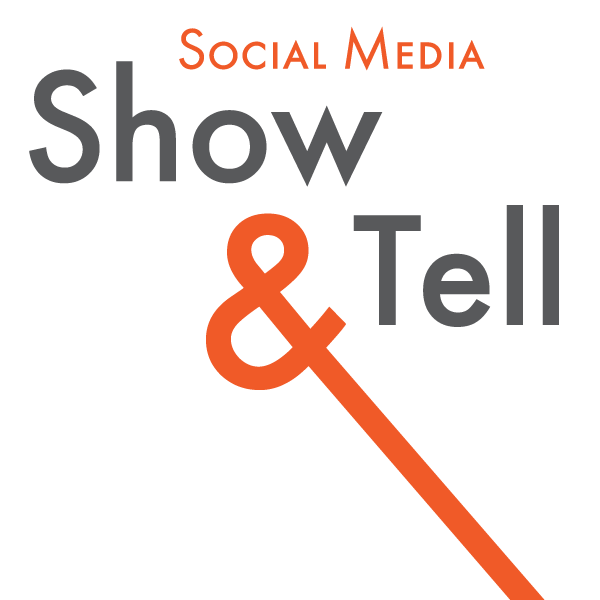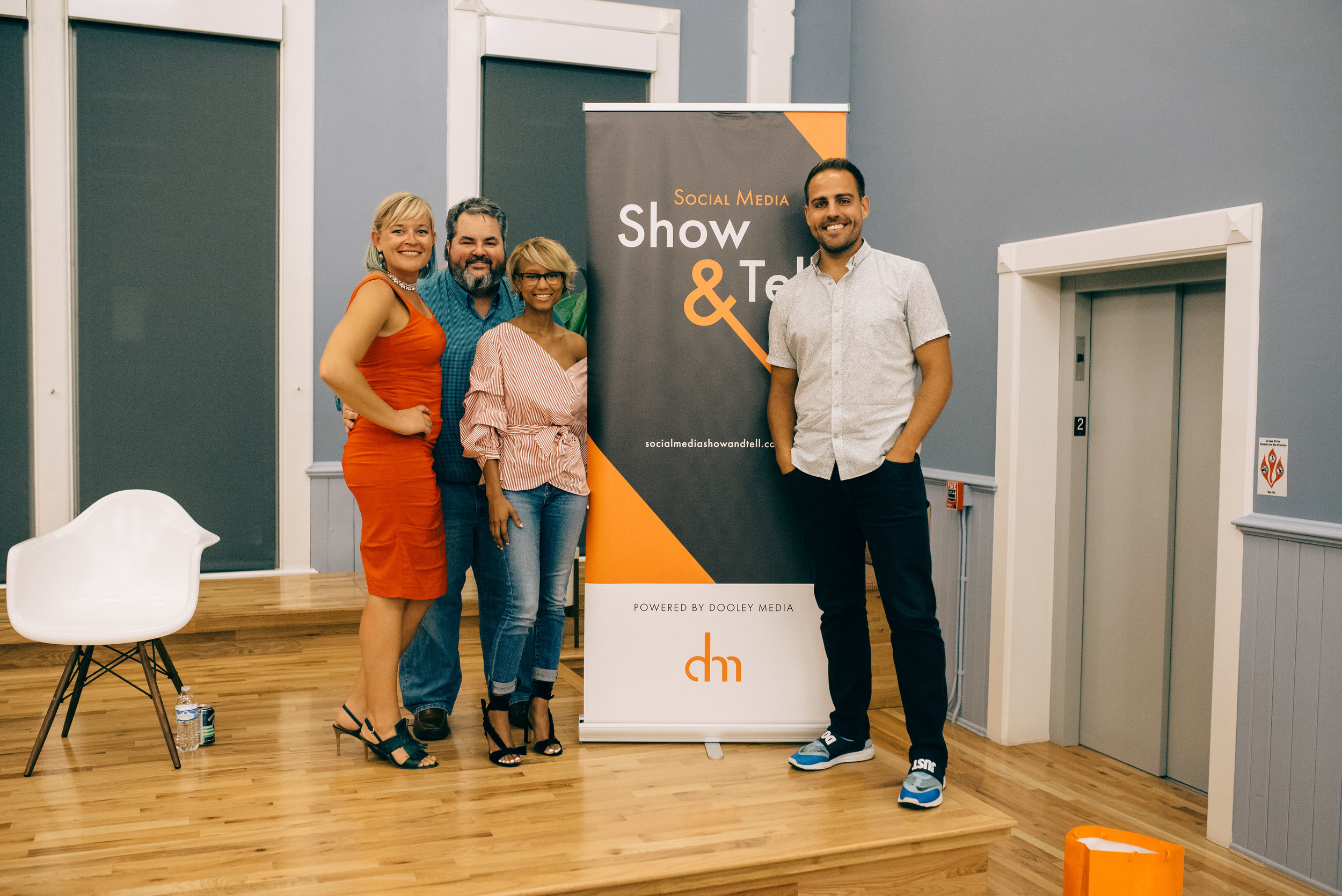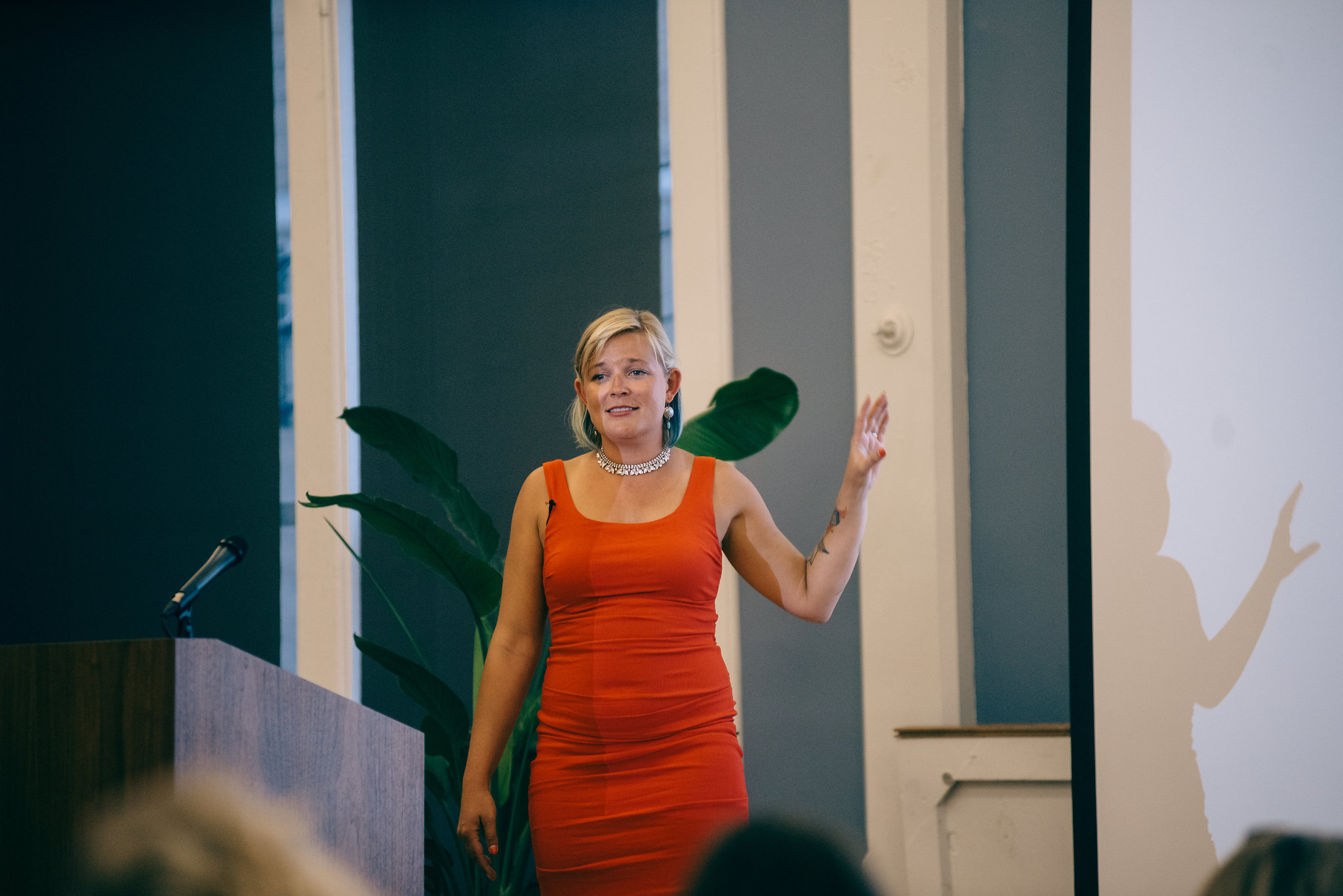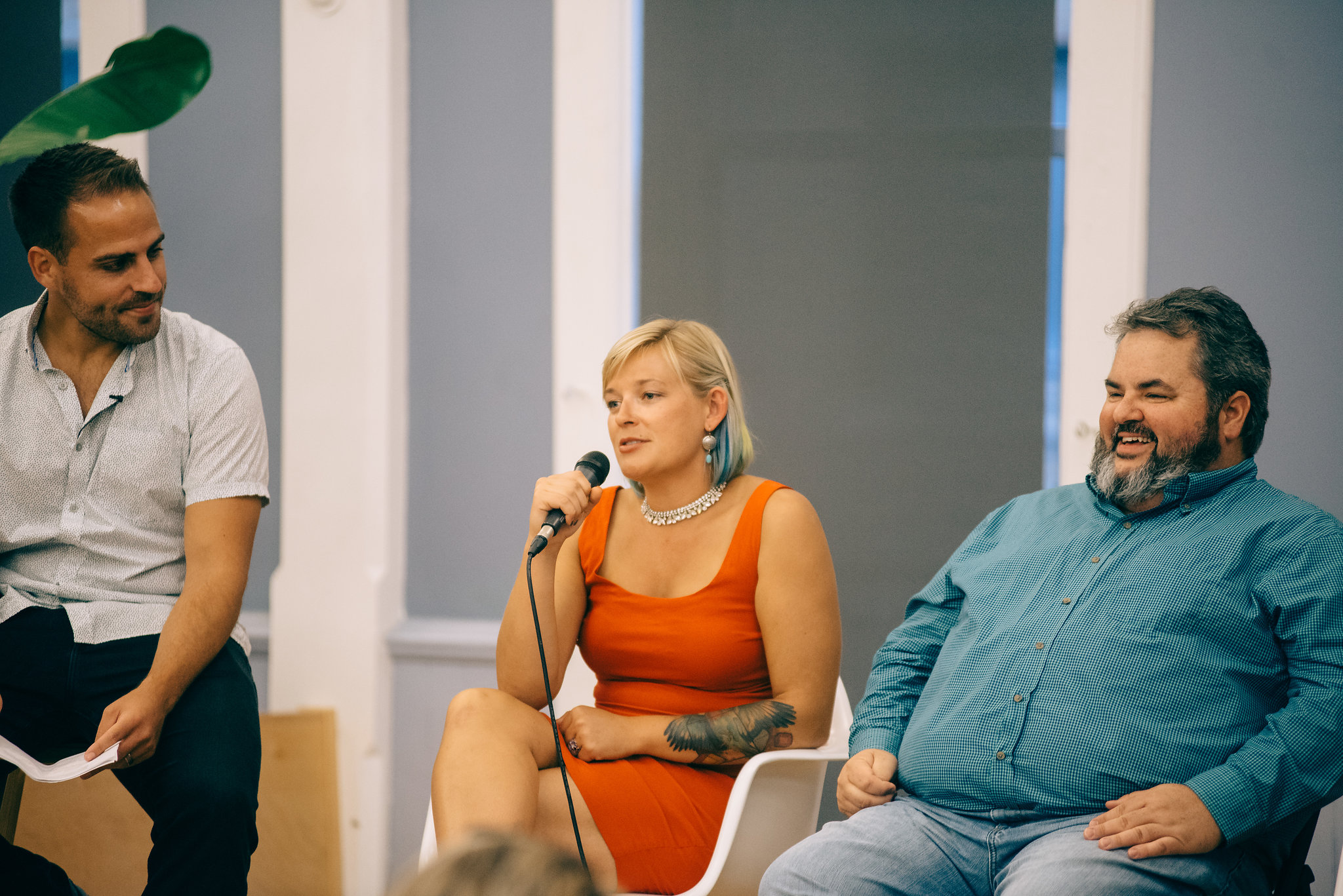August 2017 Recap
Where were you this past Wednesday? If you were anywhere but Union Hall’s Beer Hall, you missed out on a great one. The Beer Hall was jam packed with social media enthusiasts for dooley media’s fourth Social Media Show & Tell event featuring three thought leaders in the social media space. What did the speakers say? What were our favorite insights? Read on for a full event recap filled with the juicy insights and tips from Jason Falls, Ashley Bryant, and Savannah Peterson.
Jason Falls: Hacking the Conversation
Jason was up first, delivering a very informative, behind-the-scenes speech entitled “Hacking the Conversation”. Many times you don’t need to start conversations with your customers or clients. The conversations you need already exist. How can you tap into those? It’s all about the research. Throughout his presentation, Jason explained how he uses research for products, experiences, and messages.
Your customers are armed with tools to communicate regularly and openly about their experience. But how do you take advantage of that? Jason gave us the example of a particular agency that dug deeper into online conversations people were having about their products. They found out that Jaguar Service was accepting bids for managing their global business and wanted to get in on the action. They researched and developed their pitch, and made sure to include information to help them stand apart from their peers. They listened to experiences and conversations happening online in order to complete a SWOT analysis of Jaguar’s service. They were able to show Jaguar first-hand that they had specific weaknesses in the US & UK and recommended potential solutions. Can you guess which agency Jaguar gave the bid to?
“Customer service interactions on Twitter over the past 2 years have increased by 250%.”
Jason then detailed a story of negative experiences people were having with a large heath care provider. A quick breakdown: "quality of care" accounted for 18% of this brand’s negative experiences. As a result, they were about to spend tens of thousands of dollars on traditional surveys in an attempt to uncover what was causing these negative experiences. However, Jason took a look and found out that all 18% of those negative experiences were being driven by only four people. Four people! These four people were ranting about abuse by staff members, criminal investigations and amplifying negative news articles. By tapping into these online conversations, Jason figured out in one afternoon what would have taken weeks to dig up with traditional research methods.
As an another example, Jason worked with a CPG company to uncover customer insights about the company's dinner products. He started by looking into various messages customers were sharing online, by simply starting with a search on the word “dinner”. With that search, Jason was able to see a timeline of positive/negative experiences related to dinner, as well as how passionate people were about those positive/negative feelings.
Based on the timeline, Jason could easily see a huge swing where people had a much more negative experience and were very passionate about them. What was the cause? The large swing in experiences occurred right around back-to-school in August. Families were hectic and out of their normal routine. The experience with dinner returned to normal a few weeks later. What does this mean? “The insight I found for this company was to adjust your content in that timeframe to talk about fast, easy, and simple meals. By playing into those trends, you can tap into experiences your customers are struggling with.”
Key Takeaway:
“You need to understand what your primary product is, understand why your customers are talking about it negatively, and ultimately that will help you understand the corrections that you can make.”
Ashley Bryant: Moving Passion to Action
Ashley is a builder of brands and movements, so she gave us insights on how you can inspire people to act. It all starts with having a specific plan and unified message. She laid out the process of building a plan very similarly to building a marketing plan. To start a movement, you need:
- Mission: Your ultimate end result or achievement
- Goal: Objective that must be reached to advance the mission
- Strategy: Plan of action to achieve the goal
- Tactics: Specific actions taken to carry out the strategy
So now you have your movement’s plan drawn out. But how do you grow your movement? Ashley explained “Movement building is fundamentally about meeting people where they are, and your movement will not be successful if you can’t do that. Some people will be attracted to your movement inherently, but you’ll have to work to bring in most people.” A key way of doing so is having a unified and complete digital strategy - unifying website, email, social, and online ads - and setting the right infrastructure to support them.
Ashley gave us two examples, each of which varied on their level of effectiveness.
- Marriage Equality Movement: “Marriage equality was able to not only reach the people directly involved, but they were able to meet a lot of people where they were and brought them in.” This movement had seamless and consistent digital tactics, staying true to their branding while resonating with their target audience.
- Occupy Wall Street: “This movement had the potential, but they failed on keeping their movement cohesive.” The movement had several different agendas, no digital infrastructure, and no clear calls-to-action.
You don’t always have to build a movement from scratch, however. There are plenty of chances for a brand to join in on a conversation and be a meaningful part of a movement. However, as easy as it is to join, it’s just as easy to fail. “Your VP of Marketing might come up to you and say: ‘We need to start adding value to a particular client. Let’s join a popular conversation/movement.’ They’ll give you the plan of how, but there is no why being considered. When brands enter a movement without fully understanding why they’re entering the conversation, this happens..."
Ashley has developed her own "Theory of Change" as a result of her experience. First, you always have to consider the “why?” Once you know your why, you can move on to successfully growing your movement with these steps:
- Acceptance: People are who people are. You have to accept where they are or what they do and meet them there.
- Listen: Testing, testing, and more testing. Do your own research before you go out and spend loads of money on a specific campaign, only to find out it’s not right.
- Train: Train your audience. Slowly moving people to the next action. Think: “What do I need 6-weeks from now? How can I start to train them for that action now?”
- Reward- Give them something that makes them want to be there. They will continue to be a part of your community, while also being an advocate.
“Our largest fundraising email for Obama’s campaign had the subject line “Hey”. This was so successful because we accepted where our audience was, we listened and adopted their language, we trained them in previous emails, and we rewarded them with giving them attention.”
If you’re thinking about taking action or building a movement, follow Ashley’s Goals of a Digital Movement Strategy.
- Acquisition- most lists have a 20% churn rate each year. Make sure your lists are up to date, and you’re constantly trying to bring more people in.
- Organizing- Ensuring your message is consistent, and that there is a clear message. You’ll be able to remind people why it matters, what they’re a part of, and why it’s cool that they’re a part of this movement.
- Fundraising- Never leave a dollar or donor on the table. This is all about the relationships. Know that it starts with a conversation and can take time. “I’m a big advocate of the hard ask. Share exactly what you need and why you need it.”
- Messaging- If you don’t tell the story, someone else will for you.
Key Takeaway:
“Digital isn’t just a set of tactics. A lot of brands want to do it, but they don’t really know why. They usually know the how and they’ll have a document of what they want to happen. The problem is, they don’t know why.”
Savannah Peterson- “The Channel is Free”
Savannah is a constant live streamer, so she interacts with her audience a bit differently than you would with most social media posts. Her audience is right in front of her, live, in real-time. Sounds a bit scary, doesn’t it? She actually surprised the audience by going live right then and there, live streaming the entire presentation...about live streaming.
Savannah gave a little background on video creation: “You used to be at the mercy of the television networks. You needed an enormous budget to get your content on the channel. But now, the channel is free. You have the opportunity to test anything you want on your audience, for free.” Savannah gave us some key rules as well as some key insights.
It starts and ends with your audience: engage them
The whole reason you’re able to create and push out content is because of your audience. If you had no audience, there would be no content. Because of this, you have to make sure you are actively engaging with them. Typically this means replying to a comment on a recent post, or replying to a message a fan sends you. Live streaming is a whole different story however. “Your audience is just like me and you. You don’t need to be perfect to engage with them in real time. We aren’t all Katie Couric. We aren’t all born like her. Be yourself and your fans will appreciate it! They won’t care if I haven’t showered. Most of them wouldn’t even notice. They care about the engagement and your interest in them.” Savannah suggests asking your viewers questions like “Where are you watching from today? What’s your biggest pet peeve?” Asking your fans questions will show them that you’re interested, but also it will make the conversation much easier.
Anyone (who wants to) can do live video
Savannah drew on an example from the 1930’s, when advertising was all about “Anyone can do it!” She backed up the thought with an evolution of video content timeline. “It used to be that only the big networks could make it. Then only the rich or famous people could be in it. Then everyone started doing it. Then the message became ‘We’re doing this for you!’. Right now, we’re in the middle of a stage where we are a part of the show, and soon we’ll move into ‘You are the show’.”
Do what works for you & your audience
“Who cares what so and so is doing. The way I want to hear it is ‘Here’s 5 different things I’m going to try.’ I don’t want to see ‘Here’s 5 different things other people have tried.’ That’s not innovation. Innovative content doesn’t come with a script.” Looking at current trends and what your competitors are doing can be helpful in building your content. You have to make sure, however, that you are always putting your own spin on it. By putting your own spin on it related to yourself and your audience, you’re showing your audience that you know what they like. You’re showing them that you know how to engage with them rather than having cookie cutter content that doesn’t relate to them on a personal level.
The (story) channel is free!
Savannah gave us some compelling statistics on live video:
-1 minute of video contains 1.8 million words. (That’s about 57,857 tweets)
-80% of brand audiences prefer live video to any other type of social post
-Video is shared 1200% more than images and text combined
(You can find all these stats and 59 more on livestream.com)
Now, let’s talk about Bronies...
A Brony is defined as an adult male who is an extreme fan of the My Little Pony franchise. Why are Bronies important here?
“I never knew about the Bronies before this story. At Shapeways we had no idea who was using out product. We were sitting on a piles of data trying to analyze it, when all of a sudden all these colored ponies started coming out of the 3D printers. We tried to figure out where it was from, which is when we found out that the Bronies were making custom ponies. Then we found out that they were also starting to sell their custom ponies to friends, which is a big deal with copyright laws. Ultimately we received notice from Hasbro that we had to stop the creation of these ponies. The most horrifying part was that we literally had to smash all these ponies per instructions from Hasbro. The Bronies came together, wrote a few letters to Hasbro to express their displeasure. We didn’t think it would amount to much, but 6 months later we opened up the first open source 3D toy printing. We wouldn’t have even hired lawyers to go after Hasbro for the copyright laws... but the Bronies made it happen. After this, someone sent us a 200-word Bronie dictionary, which is basically priceless. With that knowledge, we were able to put out our usual content, but also specific content to our very own Bronie audience. We ended up creating a partnership we couldn’t have made because of these dudes. Had we not taken the time to get to know them, we would have missed out on a giant opportunity.”
When in doubt, go off script!
Right before Christmas, Shapeway’s website went down. Since Shapeways is a large 3D printing company, Christmas was a huge time of year for their sales. It just so happens that a backhoe took out their data center at 3AM four days before Christmas, causing their website to be down indefinitely. Being in New York City, there are strict laws that prohibit construction during business hours. “Thinking I have no idea what to do, I went on our social media accounts and put out a blast telling people to post pictures of their pets. At the very least, we offered a prize to those who shared pictures of their pets. I basically ended up meme-ing our downtime.” Savannah didn’t let it stop there, as she was looking for a Hail Mary to continue to save the day. While scrolling through the posts, she found out one of their 3D designers dressed up as Santa every year, and he was printing a sleigh for his reindeer. How perfect is that?! After the Shapeway website was down for 19 hours, they invited Santa to their factory and captured the moment of him taking presents to kids.
Key Takeaway
“Trust your community, and get to know them. You never know how your fans will be able to surprise you when you show them that you care about them.”
Panel Discussion
Once each of our speakers took the podium, we had a short break before starting our up-close-and-personal Q&A panel. Attendees had the chance to ask their burning questions to our social media thought leaders. This was an AMAZING discussion, with lots of crowd participation.
Social Media monitoring- What should you do when you don’t have the keyword or topic to search? How can you start really broad and be open to ideas?
Jason- Focus on the movement within your industry. Netbase and Advence platforms have come up with a new audience profile tool. Instead of looking for a keyword, you can start with an audience like “working moms” and see what they’re already talking about. You start to research and drill down questions like: What do I not know about the audience I’m looking for? What happens when I’m looking for people who buy parakeets? Start with parakeets. You can start free form, and you’ll find out more than you expected.
Are Millennials entitled, or misunderstood?
Savannah- We all have new communication tools today that amplify the message. The same way the Millennial is Snapchatting or doing all these things from their phone, their parents are complaining just as much about it on social media. We’re the largest living and largest spending generation. You need to put your foot in your mouth and learn how to sell to Millennial and connect with them. Millennials aren’t the devil or entitled. We’re just different, and we have a greater problem with things that weren’t problems 10 years ago like starting a savings account.
Jason- The word is not entitled, but empowered. They’re the first generation to be empowered by their parents growing up, rather than being put in a box of “You’re going to a trade school” or “You’re doing what I did for a living”. Millennials just have been raised differently.
Crowd Question: What are some specific/practical things you have in front of you, to keep you ahead?
Ashley- It spans across corporate and political. It's all about multi-touch approaches, low budget imagery, and timing. You can’t always start the hashtags, so just join another conversation where you can build the authority of your voice. When we’re talking bigger budgets, you can chase people throughout their Internet journey, step by step. Not every ad needs to say “buy” or convert to something. It can just be a quirky thing to make someone stop and think. A lot of the ads where you’re reading an article, and the ad doesn’t take you away from that article, are successful. Making sure you’re not distracting them, but making the ad fit in to where they’re already at online. Don’t always try to convert always every time. That said, a hard ask is always the best ask in my opinion. A direct, hard ask will get you to the end result better than trying to coach people. Don’t do multiple asks. Don’t ask to share, buy and click. Choose one at a time to train them to a larger goal.
Jason- The best copywriter of all time is a robber, “Give me your money”. Direct, to the point.
Tip: for anyone who reacts to your FB posts, you can easily click and invite them to like your page. The invitation comes from your page, so it’s very effective.
Why did you say 1,000 highly engaged fans are better than 1 million average fans?
-Savannah: Myself plus a small team can give those 1,000 fans great content and great connections. We can relate to them 1:1, even 10:1 is important to them. It’s all about the value of the engagements and conversions. Who doesn’t want 500k customers? But you don’t need to communicate with each of them. You can build yourself a “Nest”, which is a smaller group of fans that are just as passionate as you are about your product. There are 5-10 people I always look for to engage in my content, and if they stop responding (and I can see they’re not on vacation) then I want to know why they aren’t and what’s going on. That personal attention is much easier to tell a story from. Look at who you’re converting, not just how many you’re converting. Worry about growing your “Nest”.
Matthew- Make sure that you never take one person for granted. That one is better than no one, and that one amazing relationship matters a lot more than a 100 so-so relationships.
“When posting an Instagram story, I watch for the people who stay with the string of 6 story posts. I see who watched the first, and watches all the way through the end of the string. I’ll send them a direct message to connect and make them super fans.”
Crowd Question: How can I better engage and reward my gym members for checking in all the time?
Savannah- Find a way to make them a exclusive club, or give them a reward for being the top visitor each month. You can also make a private Facebook group, and people love it. You have the ability to discuss exclusive access or hot topics with 15-45 people rather than your whole following.
Jason- Especially in fitness, sometimes it’s really just that small validation. Even just liking their post or a “Hey great job” comment.
Ashley- Maybe let them take over your social channel and show off themselves/your business. Let them be an organic brand ambassador.
Matthew- If they’re taking action past just engaging with your post like checking into your page, you most likely have a story and a story teller. You can start a relationship with them, while ensuring it’s about them and not just promoting your brand. You’re able to spread your brand, by taking the focus off of yourself and shifting it to your fans.
Crowd Question: How frequently/ how often should your content be 3rd-party content?
Ashley- There’s no magic number. Most content is already being repurposed by big companies. For smaller companies, it’s all about your content curation and putting your own spin on it. It can help you build partnerships or relationships. If you’re always sharing someone else’s content, you can start reaching out and contributing to each other’s content. You definitely want to have your own content, but as long as you put your spin on the 3rd party content it’s good to curate content.
Jason- I take 45 minutes every morning, and I go through social media and digital blogs that I want to share. Fans are thirsty for good knowledge, and they don’t care where it comes from. They just see it coming from you really. People know I’ll filter the web and provide good reads, so reputation lets me just say “Hey great article here”. If you start to provide really important information, then you can carve out your reputation where people trust what you’re posting.
Matthew- Personally, I want to know why I should read it and briefly what you got out of it. Do the homework for me. Another trick for third-party content is considering the stuff that isn't published yet - source your opinions from people other than yourself, then feature them in your piece, and they'll be sure to share if for you and thereby reach new audiences.
Savannah- If I can tell you’re just trying to hit your mark for sharing 5 posts each day, then don’t do it. Make sure you’re sharing the right reasons.
Crowd Question: Opinion on Twitch?
Savannah- They’re winning the live-video game right now (look at that pun). I’m not a gamer, but when I look at something like Twitch I see that they’re showing people at their best. There was really no other way to go watch this kind of stuff other than showing up at a friend's house and jumping on a LAN party. It’s different than your typical sports, but these people are very talented at what they do. Very intelligent niche targeting.
“Don’t be platform schizophrenic. Get on a platform, claim your username, and take a breath. Pick 1-3, and just rest. Don’t go crazy and feel like you have to start right away, relax. Place your bets where your audience is.”
Crowd Question: I work at a local university and hire students, what are some skill sets you think are important for college students to have?
Matthew- Thinking of the marketing field not as a job or a title, but every time you interact with someone. It's an attitude.
Savannah- Community management, some analytics capabilities, and create case studies from what you’ve worked on. I don’t care about your grades or school, I care about things you have genuinely done. Digital media is a very hands-on career.
Jason- Be able to communicate, and be curious. People come out of college and they think they know everything, but you need to be able to ask questions because then you’ll always be learning more.
That's a Wrap
Social Media Show & Tell #4 was one for the books!
Thank you to all who attended, we had a blast and learned a lot!
What was profound? What did you learn? Be sure to comment below and discuss.
Check out our Past Events for more recaps and thought-leader teachings!










